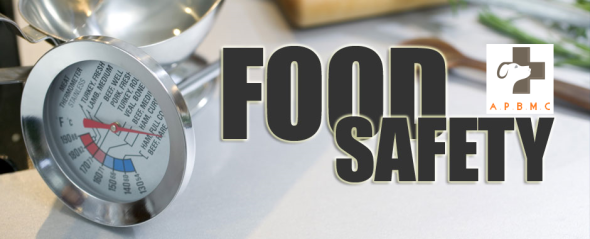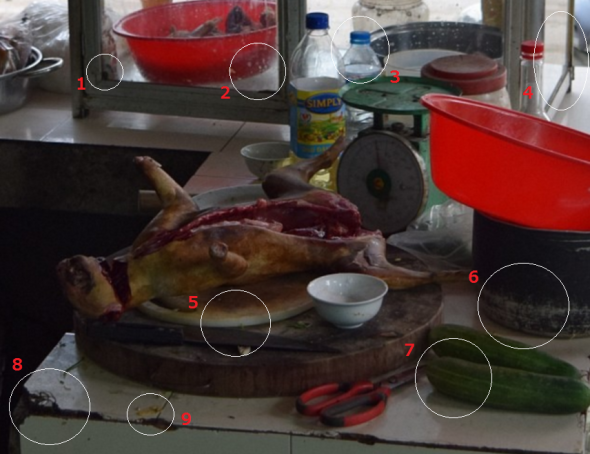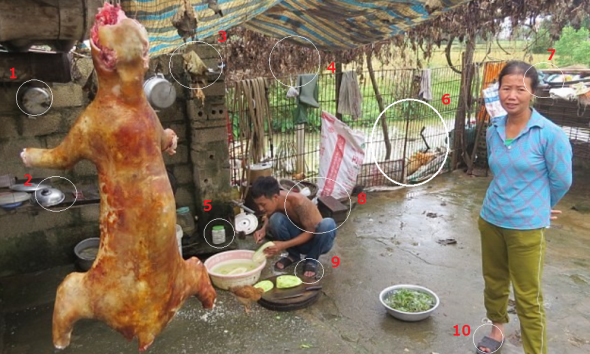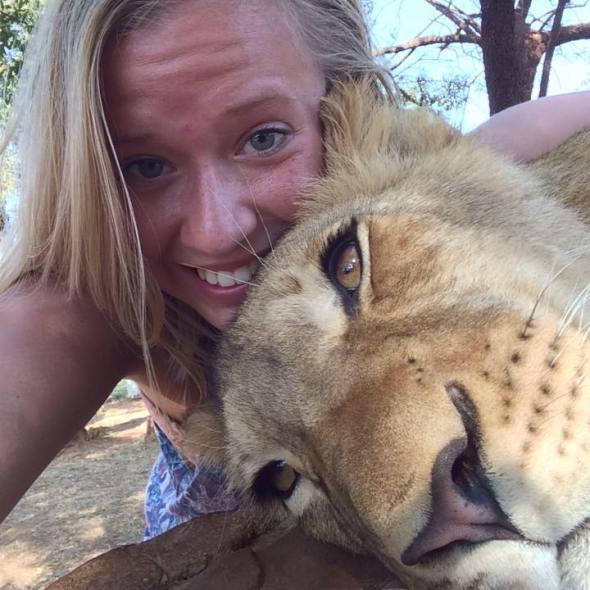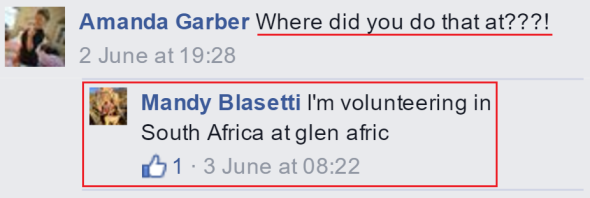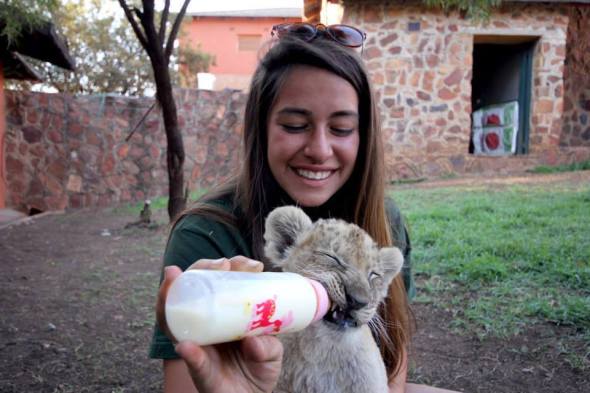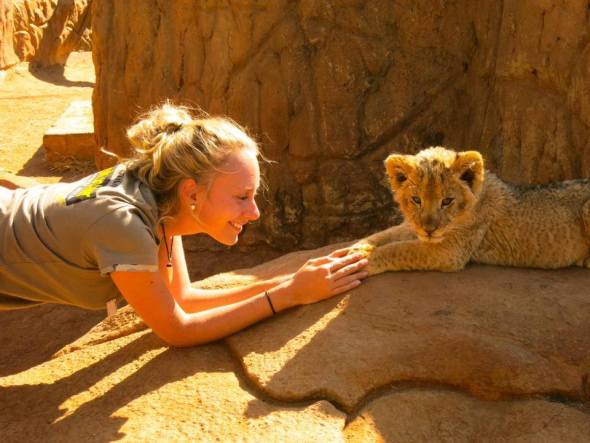Food Violations - Pet Meat Trade | Food Terrorism.
FOOD VIOLATIONS IN THE PET MEAT TRADE
One of thee biggest and most concerning problems I witness within the pet meat trade is multiple food and hygiene violations. Violations that place both human and animal life at risk of disease and in worst case scenarios - Death. Furthermore I often witness many organisations online that either disregard this critically important health risk, or seem more concerned about posting graphic images on the trade while soliciting donations, yet seemingly not bothering to educate their viewers on the “importance of these images and videos, down to how these images and videos can actually help to wipe this repulsive trade out once and for all”.
So today I have again decided to document on such violations, but am going to educate all seven million of our viewers around the world of just how serious the images depicted herein actually are. I am going to keep this document as easy reading as possible, while detailing the facts briefly but in as much detail as I can (without confusing people with scientific jargon). Below I have included a number of images within this document. The images contain small white circles that point out minor and extremely major food violations, all of which in the Western world would see such vendors and restaurants closed down immediately for placing public health at risk of contracting diseases.
FOOD VIOLATION | CROSS CONTAMINATION
Firstly I want you the reader to think - If I hadn’t of circled the most important food violations within this image below, what would you the viewer think of this image? Let me try and answer that question for you. Firstly I’d most likely be enraged that a dead feline had been slaughtered, and is now being prepared to cook to consume. And secondly, (there is no second). There is no second because my own anger, frustration and shock has overwhelmed me, of which that is all I see within this image, a dead cat, and nothing more.
I am now technically angry, and upset that someone has killed an innocent cat, and then I move onto the next image. My next thought would probably be to either leave a derogatory comment under that post, or to donate to the organisation that hasn’t shown any information or education about this image or any “graphic” pet meat trade image whatsoever.
Within the image above I have highlighted nine of the most common food violations that would be prompt any food safety inspectorate to immediately close this restaurant or vendor down within the modern western world. What are these violations? Let’s take a look.
- The window in the far left has a cracked wooden frame that bacteria would/will thrive within.
- On the right hand side of the window is mold that bacteria will grow within, that’s not forgetting the toxic spores that the mold would emit in to the ambient preparation environment thus ending up on the surrounding food itself leading to food spoilage.
- A water bottle that is possibly being used by the cook looks pretty innocent doesn’t it? Well that pretty innocent water bottle is situated next to an uncooked dead animal carcass. While the bottle may be sealed, the cook may cross contaminate that bottle with blood from the animal, simply by a single touch of his/her hand. Once the bottle is turned upside down to drink from, blood drains from that bottle into the cooks mouth which could or will see food poisoning occur from secondary cross contamination.
- The white circle in the right hand side of the image, shows an open window. While that open window may look innocent, the open window is a free entry for pests and diseases to enter into the preparation area thus spoiling the food (E.g.) flies, aphids, and parasites. Furthermore should the outside environment temperature be warmer than the inside ambient temperature, food such as meat, dairy, or cooked meats will heat up, which will see bacteria multiple on the foods spoiling them. For every twenty minutes bacteria is present, that bacteria will double in number. 1,000 bacteria = many thousands more.
- Dirty chopping boards can harbor thousands if not billions of bacteria, furthermore if this chopping board hasn’t been washed or even replaced every six months to a year, it looses its triclosan (antibacterial cover) which helps to kill off bacteria. While there is a wooden board present, that too is just as disgusting and filthy, and harboring anything from a million to a billion bacteria.
- The black bucket itself is a breeding ground for any bacteria to thrive in. The black bucket has what looks like chaff marks on of which bacteria will weed themselves out of and contaminate any food nearby.
- Vegetables that are unprepared or prepared shouldn’t be anywhere near a “raw meat preparation zone”. Vegetables and meat cooks at different temperatures, furthermore meat and vegetables require either shorter or longer periods of cooking. Salads should not under any circumstances be anywhere near “raw meat zones” whatsoever.
- Cracked tiles are the perfect breeding ground for any would be bacteria to grow. Furthermore cracked surfaces cannot be cleaned adequately which in turn leaves the area unclean. I wouldn’t even want to guess how many millions of bacteria are actually present within this single cracked tile.
- Blood and general dirty surfaces is not good food practice, and should any salad vegetables come into contact with this surface, I’d hate to think just how much bacteria the “customer” would be consuming (over that of pet meat).
The above nine food violations are commonly seen within all Asian and African unregulated food trades. These type of violations are commonly identified as (cross contamination’s). With no regulation or even monitoring of these trades, it paves the way for trillions of bacteria, diseases and virus to spawn their way into the general public’s food thus equaling food poisoning caused by human negligence.
As a human and environmental scientist I am at the best of times shocked if not perplexed at the sheer ignorance of Asian and African governments that are all up for protecting human health and safety, yet unregulated meat trades such as the above - are an imminent disaster waiting to happen on a gargantuan scale. On one end you have armed forces and police protecting people from terrorism or terrorists of which each terror atrocity kills on average 100-200 innocent civilians (Est). Yet in Asia a staggering (700,000) people die from food poisoning annually. Source: http://www.iccservices.org.uk/pdf/Food_Poisoning_Facts.pdf So I think its safe to say that food poisoning viruses are indeed the biggest threat to homeland security, something Asian and African governments seem oblivious too.
“FOOD TERRORISM KILLS 700,000 A YEAR IN ASIA ANNUALLY”
Lets leave food poisoning out of the equation now and concentrate on actual “human on human terrorism” of which in the past year terror attacks have risen by 80% in the past 365 days. Furthermore lets not forget the very (concerning 700,000 thousand innocent people), most of which are food consumers that are killed by poor food hygiene in Asia alone.
Back in 2014 the Global Terrorism Index (GTI) stated that some 32,658 people were slaughtered by terrorist attacks worldwide, totaling on average a combined 140,000 terror attacks. 2014 was marked by the (GTI) as being the largest kill rate seeing terrorist kill rates soar by some 80% in a single year from 2013-2014. Source: http://economicsandpeace.org/wp-content/uploads/2015/11/Global-Terrorism-Index-2015.pdf
The index ranks the level of terrorism in 162 countries - representing 99.5% of the world’s population - by measuring the number of attacks, injuries, deaths and property damage as a result of terror attacks. The UK ranked 28th in the index - higher than the United States, Iran and France, although the report did not include the impact of the Paris attacks in which 129 people were killed.
Terrorism remained highly concentrated in just five countries, with Iraq, Nigeria, Afghanistan, Pakistan and Syria accounting for 78% of terror-related deaths in 2014, the index found. The UK recorded the highest number of terrorist incidents of Western countries with 102 last year, although they did not result in any deaths. The majority of the attacks were in Northern Ireland and involved the New IRA, the report said.
CAN YOU SEE THE TERRORIST?
Okay, so now I am going to show you a picture below of which its very obvious what the image depicts. An armed individual that has “probably killed numerous innocent civilians”. Can you see him? Keep telling yourself, “I can see him, he’s armed and he’s certainly dangerous looking, and he’s very much within my sight”.
 CAN YOU SEE THESE TERRORISTS?
CAN YOU SEE THESE TERRORISTS?
So you can see the individual in front of you whom is holding a rifle. 2014-2015 most of the 36,000 people that were killed as a direct result of terror atrocities and/or attacks actually witnessed their aggressor before they were killed. Asian and African governments have been quoted as clamping down hard on terrorism, yet over 700,000 people a year are killed as a direct result of food terror - yet this critically important issue within the pet meat trade seems to be going ignored. 700,000 people is indeed more people killed annually than any terror attack recorded since the WWI and WWII.
In the image below what can you see? Take a good hard long look at this image. Can you see the terrorist or terrorists should I say? The answer is of course - no you cannot see them. You cannot see these terrorists or terror “suspects” as they are approximately 50 to 60 micrometers long (I.e - microbes). Lets take a look.
The image above looks pretty much innocent in the sense that there is no immediate threat whatsoever to human life. The woman to the right is not armed, and the guy to her right is going about his daily duties of food preparation. Unfortunately there are over a dozen terror suspects within this image waiting to take action on their next victim[s]. That victim could have been anyone of the 700,000 Asian citizens that consumed dog or cat meat from unhygienic premises, that poses a direct “threat to human health” in the way of “food terrorism”. So lets take a look at these non-visible, and virtually invisible terrorists.
- A dirty cooking pan hanging from a filthy brick wall. Any species of animal could have at some point took refuge on this wall. Lets say a chicken. Chickens defecate, and with chicken defecation comes germs and bacteria. Salmonella is the number one terrorist then in this situation, as salmonella can easily be passed onto humans via chicken droppings.
- An innocent (unarmed) cooking lid, looks pretty much cool, calm and collected. What’s harboring underneath that lid though, or more to the point - what has the lid been placed on? Lets say a dog has rubbed its backside up against that wall (yummy)!. What’s the likelihood of contracting a virus? High if that lid is not cleaned. and the virus is? Toxoplasma gondii is likely. The lid could be innocently placed onto or next to raw non-cooked or cooked - foods thus equaling (cross contamination).
- Dirty rags, Mmm, looks pretty much safe, and not likely to pounce or fire a quick succession of AK47 rounds off into the air. What the hell is on that rag though that’s most likely going to be used to clean pots? Flu viruses, Rhinovirus, Norovirus, E. coli, salmonella, Clostridium difficile (C. difficile) and campylobacter are all just a handful of nasty food germ terrorists that we really don’t require within our food from filthy rotten germ infested rags. Oh just for the record, Norovirus kills over 200,000 people a year. Lovely!
- Not quite sure what this is hanging down from the main food preparation area (that shouldn’t be outside). Whatever it is, its not important as such. More what has landed or took refuge on this overhanging decoration. Let’s say wild birds have visited for a brief eavesdropping, and they want to leave you a farewell present of wild-bird feces. Any food that is prepared under that overhanging decoration can become contaminated with a STAGGERING SIXTY DISEASES that you seriously do not want in your food! One of the most serious food contamination’s is that of Avian Flu that has killed many hundreds of people throughout Asia.
- Chemical contamination of food seems to be increasing within pet meat consuming countries - especially on the Asia continent. There shouldn’t be under any circumstances any form of non-food chemicals anywhere near food or within a food preparation area. Lets say this tub of unknown ingredients is “Lean Meat Powder Pork” commonly used in Asian food preparation within China. Lean Meat Powder Pork can cause - dizziness, heart palpitations, diarrhoea and profuse sweating - in worst case scenarios this substance can cause death.
- An open filthy river, again looks pretty much innocent. However any insect such as flies can simply swoop in for a mere taste of the local specialties thus spoiling food. That innocent fly could have anything on its pads from animal dung to dog feces. The most common virus a fly could leave is that of a vomiting virus. Not really what I’d call “good customer service”.
- Hairnets must always be worn within food preparation and raw meat preparation. While there is no real major food terrorist here the woman could have touched a bloodied animal carcass, then patted her hair down. That means a cross contamination of a virus of some sort. Lets say she has touched raw pork, and then goes over to inspect the local ‘cooked dog or cat meat’. She brushes her hair again, and a loose hair follicle contaminated with raw pork blood ends up in food that doesn’t require cooking or further cooking, Hepatitis E viruses, Trichinosis, and Ecoli, are three of many viruses that can end up in food causing severe and unwanted sickness, simply by not wearing a hair net.
- The guy to the innocent woman’s right is again not really looking dangerous, apart from the fact that he has no T-Shirt on or even a protective food apron which is pretty much vile and a 100% food violation within the Western world. Aprons stop anything from hair, skin cells, down to human viruses from being passed onto the food. Furthermore gloves are not being worn for the “average of twenty minutes” that would keep a barrier in between the food prep and the food. Most common types of food virus are vomiting and cold bugs.
- Improper foot-ware is not being used within a food preparation area, which could in this case pose a danger “to the food server and preparatory individual”. We know that rabies is very problematic within Asia and accounts for thousands of deaths every year. Should anyone of the (live or dead stolen pets), be infected with rabies, and the man with no proper and safe foot-ware have open wounds on his feet, he’s likely to contract the deadly rabies virus equaling death!
- And finally in at number ten, as like the young man on the floor preparing food, the woman is also wearing open toed shoes which is again a big no no within food preparation or any food service. Unwashed nails contain the natural microflora or resident bacteria and microbes and the transient bacteria from the objects that the hands come in contact with. When the hands are unwashed, there are millions and millions of bacteria living and growing on it. And you really don’t want them bacteria in your food.
CAN YOU SEE THE FOOD TERRORIST NOW?
The whole purpose of this article is to educate not discriminate. Over 700,000 people die every-year in Asia alone from food viruses, and food contamination. That’s 700,000 too many of which The Anti Pet & Bush Meat Coalition are trying to stop in relation to the virus filled dog and cat meat trade. Please sign the petition below and help by donating via the link.
Donate here:
https://www.facebook.com/Anti-Pet-and-Bush-Meat-Coalition-474749102678817/app/117708921611213/
Sign the petitions here on Facebook:
https://www.facebook.com/474749102678817/photos/pb.474749102678817.-2207520000.1452824282./554473384706388/?type=3&theater
Follow us on Facebook here:
https://www.facebook.com/Anti-Pet-and-Bush-Meat-Coalition-474749102678817/
My name is Dr Jose. C. Depre and thank you for reading.
Dr Jose C. Depre PhD. MEnvSc. BSc(Hons) Botany, PhD(NeuroSci) D.V.M.
Environmental & Human Science
Where Are Our Children? Brutality of South Africa’s Past.
WHERE ARE OUR CHILDREN?
Introduction:
Despite our best efforts to educate and push awareness into the public domain in relation to big cat hunting and the petting industry in South Africa and neighboring countries. We have uncovered a rather large core of dedicated students and volunteers from America, Canada, eastern and northern Europe and South America that still defy the basic knowledge made public, that what they are practicing is harming both captive and non-captive felids. These students actions are contributing to the spread of disease and is supporting abuse no end. Furthermore International Animal Rescue Foundation Africa’s Environmental Investigations Unit has unearthed countless British travel agencies, South African universities and even veterinary establishments that support the petting industry. (Image credit Nick Brandt)
The Petting Industry Explained:
Since the release of the Blood Lions documentary one would have thought that students whom continue to visit these seedy and corrupt lodges, parks and alleged reserves, would have taken note that their behavior is more a hindrance to conservation and wildlife alike, rather than supporting ethical conservation itself. Unfortunately this ‘hardcore group’ of mostly disrespectful, uneducated students and volunteers have simply brushed that advice and education aside. The petting and hunting industry within South Africa is increasing in size, despite vast reams of data and evidence made public that clearly shows these industries have no value to conservation whatsoever.
International Animal Rescue Foundation Africa made it quite clear that we would expose students, volunteers and tourists that defy basic conservation education, while participating in unethical and abusive non-conservation tourism. Trainee veterinary technicians, private vets, school leavers, trainee zoologists, backpackers, doctors, judges down to missionaries, pilots and even celebrities are all contributing to the extinction of our African Lion, Cheetah, Leopard and even non-endemic Tigers. While we are aware that some infant and adult cats have been rescued via the many lodges, parks and farms within South Africa, and that other animals simply cannot be released into a reserve, the fact of the matter here is that breeding is ongoing, interaction and abuse is rife, and little if any reintroduction programs are being seen. When we investigated the industry back in 2011 never did we expect these pseudo conservation practices to skyrocket to gargantuan proportions.
Below we have included a list of students and volunteers down to visiting tourists that continue to place our African wildlife and captive species in danger from a multitude of virus’s, diseases down to actively contributing to the extinction of our threatened wildlife not forgetting abuse being played out. We have given many volunteer agencies, tourist agencies, lodges, parks and reserves ample time to clean their unethical fake conservation behavior up. They have all bar one refused. We now have no choice but to continue with our actions in the hope that this will open visiting tourists eyes, their employees eyes and teaching establishments that these individuals are aligned too, that this practice and pseudo conservation behavior must stop here and now!
Furthermore we are naming and shaming travel agencies, student gap agencies down to veterinary and South African universities too. When watching the first screening of Blood Lions in South Africa some months back, I knew that harsh measures had to be taken. We are not just fighting the main industries here, were battling multi-million if not billion dollar companies that are all aligned to one-other directly or indirectly. The whole purpose of this article (I of IIII) is to begin breaking the link, showing the evidence of pseudo conservation, educating travel agencies and shaming those that continue to defy basic and scientific education. Furthermore we are without a doubt going to bring these agencies and industries to their knees financially while continuing to expose those that abuse our captive and wild animals.
“STUDENTS & VOLUNTEERS PRACTICING UNETHICAL AND NON-GREEN CONSERVATION IN AFRICA”
The following list has been compiled showing both visiting students, volunteers and supporters of the petting industry within South Africa. We are not prepared to stop with this exposure while the industry continues to boom.
Douda Bis, Robyn Robles from Anglia Ruskin University, Hongyi Fan-devalois, Mandy Blasetti a Veterinary Assistant/Technician at Banfield Pet Hospital, Isabel Quiñone from Ejecutiva de Ventas at Diafrom, Connor William from Lancaster (village), New York, Kormákur Ingólfsson that works for Erhvervsakademiet Lillebælt, Iris Joensen that studies at Tåstrup borger og realskole, Heidi Arsenault a Plant Pathology Technologist at Canadian Food Inspection Agency.
Truman Shumway, Bernadette Pieterse who’s a Ranger at Glen Afric Country Lodge, Laura Victoria that studies at Rutgers University, Johanna Noseworthy that works at Inclusion Powell River, Eleanor Skovgaard that studies at the Scenic Artisan at University of Delaware, Alexane Francisci studying at the Concordia University, Laurence Vanmeerbeeck from Brussels, Belgium.
Lindsay Richardson that studies at ‘a’ American University, Luke Sparkes that studies at Oaklands College, St Albans, Johanna Eskelinen that works at the Yacht Week, Sharon Franks a Waitress at Grand Central Basildon, Capucine Bénazet, Lycée Guy Chauvet, Abby Ellison Ashley Snyder a Bartender/ Server at Outback Steakhouse, Emma Jayne Palfreman (self employed), Henrik Guldbrandsøy that studies at the Bergen University college, Fabienne Thoma that studies at the Zurich University of Applied Sciences/ZHAW, Caitlin Ferguson that works at Poppy and Pint.
Doug Richardson that studies at the University of California, Santa Barbara, Nadia Borg that works at Forbrugsmateriale Produktion at Struers ApS, Sue Harrison Kasperek, Eirik Lerum Vigerust from Boulder, Colorado, Torfinn Rønquist Antonsen that studies at Ørland videregående, Naomi Westhof a Highlight Editor at Sheffield United, Emma Enea whom is a Wildlife Coordinator at Nemacolin Woodlands Resort, Sandi Stein Blasetti that studies at the University of Maryland University College, Kayleigh Harrop that studies at the University of the Highlands and Islands, Roberto Francisco Newton from Hemet, California, Albert Chang that studies at the University of Toronto, Zoi Kakouris, Marie-Louise Lorenz whom works at Vibholm Guld & Sølv, Wai Duong from Bramfeld, Hamburg, Germany, Alicia Taylor from the village of Wijnandsrade in Holland.
Chao Qiu from Wisconsin, Gretchen Newell whom works at World Tennis Club, Bainet Yusufu from Ihlathi High School, Annika Beyrle whom comes from the German town of Elmshorn, Laura Coughtrey from Lord Williams’s School, Taylor Ann Chism from Spokane Falls Community College, Mari Irby from Saint Mary’s College of California, Cathryn O’Sullivan from London, United Kingdom, Katharina Winther whom works at Konsulent at Københavns Kommune, Tathiane Forão from the Federal University of Pernambuco, Randy Risher from Phoenix, Arizona, Glen Peck from the University of Tech Pretoria, Ruby Bell a Clinical Nurse at Healthcare Australia.
Katrine Tufteland from Oslo, Norway, Amandine Pascal, Isabella van Rijckevorsel from the Leiden University, Sherie Darmon from Toulouse, France, Melissa Quinn that works at Nando’s Parrs Wood, Amy Steele a Team Leader at Capital FM Arena, Georgia Mae Lipsham, Customer Services Adviser at Rich Products, Linda Schneider from the University of Miami, Esme Abbott, Shyoo Hayashi Marcus whom works at The Bank of Tokyo-Mitsubishi UFJ.
Sophie McCutcheon, Adam Mark Blake from Portchester, Andrew Bond whom works at Nationwide Insurance, Sandra Nuschele, Nikoline Jensen a Vikar at Børnehuset Eremitageparken, Natty Brown from the Catholic School of Archbishop of Ilsley, Nick Bruno, from The University of the Arts, Nico Schütze from the IFM - Institut für Managementlehre, Ty Broddle from Liverpool, Becki Warshow a Substitute Teacher / Volunteer Tutor at United South End Settlements, Shiran Cohen, Maale shaharut, Steve Lin, Aldo Neto, Bruno Garrido a Shop Seller at MSC Crociere, Julian James whom works at Liceo Scientifico Vittorio Veneto, Natacha Ferreira Ginja from Salto, Sao Paulo, David Chadwick from Northcote High School Michelle Dennis, Jade Vardy, Juliette Richard from Paris, France, Amanda Lynn whom works at Volunteer Southern Africa.
Graham Wilkin ‘a’ Security Adviser, Yaqin Song a Graduate Research Assistant at Georgia Tech, Stella Maria Galíndez from Buenos Aires, Argentina, Dan Maslach a Mechanical Engineer / Fuel Cell Lab Manager at U.S. Army TARDEC, Amanda Gross from the North State Carolina University, Andy Barrowcliffe from the Whitcliffe Mount College, Emily Rabska whom is a Kennel Supervisor at Eau Claire County Humane Association - ECCHA, Daniel Stratti from Sogndalsfjæra, Sogn Og Fjordane, Norway, Jo Kamenir, Full-Time P.E. Teacher at Epic Christian Academy, Lea Francisci from Montreal, Quebec, and Franziska Romrig.
The list above has been taken from a public database of which we [the organisation] haven’t committed a criminal offence in obtaining this data. As you can see above the vast majority if not all students, volunteers and supporters have no real expertise within conservation or animal welfare. Many of the individuals above are school or university goers or leavers, gap year students, or just general members of the public whom have on their own accord freely researched petting and reserve industries. From our own research we know that the vast majority of these individuals have visited South Africa via the company known as Volunteer Southern Africa that offers you the chance to volunteer at parks, lodges, farms and alleged ‘conservation teaching/science establishments’. On contacting the Volunteer Southern Africa organisation the company stated:
“We offer those the chance to assist in rearing and abandoned cat programs to help threatened and endangered species”
International Animal Rescue Foundation Africa see’s otherwise, and so should those that are offering students the chance to interact with baby Lions, Cheetahs, Tigers and Leopards. While we do not dispute the fact that some establishments within Southern Africa do run programs for orphaned and abandoned cats. Professional big cat rescues and orphanages do not under circumstances allow you to interact, walk, pet or pick up captive animals, moreover if they do allow interaction [this practice is very minimal]. Nor will these ‘professional’ rescues and orphanages continue to breed such animals thus again allowing the public to interact while making a tidy profit. And its not just these industries within South Africa, Zambia and Zimbabwe that are making colossal profits too, British travel agencies as explained above are also cashing in on animal exploitation (and they know it too).
No felid from Lions, Cheetahs, Leopard or Tigers can if hand reared ever be freely released into the wild, and if released into the wild the chances of their survival is incredibly slim. Yes there are such cases from which animals have been reintroduced into the African wild after being hand reared or kept within captive facilities for the vast majority of their lives, however these are rare and very few animals do actually survive.
Ukutula Lion and Research Center, Glen Afric, Lion Park, The South African Lion Park, Volunteer Southern Africa, do not under any circumstances reintroduce anyone of their animals that have been reared or sold to them from unidentified individuals ever release their cats into the wild. What these five unethical organisations actually practice is ‘cub petting’ and ‘adult cat petting’ which goes completely against the ethics and rules of conservationism. Moreover the five identified industries above and countless more are being endorsed and supported by the following professional establishments; Veterinary Faculty at the University of Pretoria at Onderstepoort, the Zodiac Animal Clinic and Old Chapel Veterinary Clinic in Pretoria. What’s even more worrying is that despite the public outcry, Blood Lions documentary and worldwide condemnation at such practices (even when evidence is shown of abuse), The Department of Nature Conservation undertakes checks to ensure that all abuse is being played out according to South African law. (Excuse the sarcasm there)..
Environmental Conservation Scientists and Wildlife Veterinarian Officers are becoming increasingly frustrated at viewing such hypocrisy from local and, overseas tourists that are allegedly promoting animal welfare and rights. Take Mme Mandy Blasetti, from Elkridge Maryland. Mme Blasetti works at the Banfield Pet Hospital in Maryland whom back in June of this year visited the Glen Afric Lodge.
Image 1&2: On questioning Glen Afric, the lodge stated that petting was not on the agenda.
As a Conservation Scientist myself I know very well that such human interaction only inflicts more harm to our African Lions than is being seen within this ‘very innocent looking image’. I’d have expected better too from a so called Veterinary Technician that of my own understanding should have been taught at university or college that this behavior is totally unacceptable. But why is this behavior unacceptable, what is the big issue about petting? Firstly many people that visit game lodges, parks or farms believe that just because hunting is not on the agenda (or because they are not aware of it), these animals will not suffer. That itself is complete and utter nonsense. So lets talk petting.
“Breeders and captive felid keepers quote many the following answers to questioning students”
Breeders, farms, lodges and “big cat projects” who charge or ask the public to pet and take photos with young cubs often tell people the following lies:
- That the exhibitors are “rescuers” and operate “sanctuaries”.
- That the cubs have a good life while being used to make money.
- They enjoy being moved about and repeatedly awakened and handled by dozens of people all day.
- That blowing in the cubs face “calms” them down.
- That dangling them by holding under their front arms and bouncing them up and down “resets” them.
- That close up photos with flash does not harm the cubs.
- That it is safe for the cubs and for humans, and legal, to allow contact with cubs from when they are only a few weeks old to when they are six months or more old. (In South Africa this is still legal).
- That the exhibitor must keep constantly breeding and using the cubs to make money because that is the only way he/she can support the adult animals he/she keeps.
- That the exhibitor is doing this to promote conservation in the wild.
- That the exhibitor is teaching people not to have exotic animals as pets.
And the biggest lie of all: - That the cubs will have good homes after they get too big to be used to make money from petting.
“Are you a student that has been given anyone of the answers above? If so your promoting pseudo conservation, none of which has any value to conservation whatsoever”
We [the organisation] know too well that any petting or interaction industry that is either supporting hunting or indirectly supporting the canned hunting industry regularly reads our articles. We also know that they go to great lengths to clean their image up while still promoting pseudo unethical conservation. Lastly we also know that many breeders, lodges, parks Etc. will think up many different alternative answers to visitors questions after reading the above, as they know countless supporters read our articles. That’s what makes International Animal Rescue Foundation stand out from other non-governmental organisations. We don’t only fight to prove our point, we provide scientific facts from non-related experts and our own experienced scientific team too.
Virus and Disease
Petting, breeding and “big cat projects” rarely do tell their visiting students, volunteers and tourists the dangers in relation to petting cubs and adult cats. Within South Africa the current protocol (although its not necessarily the law), is that all new born cubs must be vaccinated from the ages of six weeks old. New born Cheetah, Lion, Tiger or Leopard cubs are not vaccinated automatically after birth. This in turn places visiting students and volunteers in danger of catching ‘a zoonotic disease’.
What is a Zoonotic Disease?
A zoonotic disease is a disease that can be passed between animals and humans. Zoonotic diseases can be caused by viruses, bacteria, parasites, and fungi. These diseases are very common. Scientists estimate that more than 6 out of every 10 infectious diseases in humans are spread from animals to humans. Still believe the industry is safe? Lets take a look.
A May 2011 statement from the National Association of State Public Health Veterinarians (NASPHV) recommends that the public be prohibited from direct contact with cubs due to the risk of illness to humans stating” …ringworm in 23 persons and multiple animal species was traced to a Microsporum canis infection in a hand-reared zoo Tiger cub.” Zoonotic diseases — those that jump to humans — account for three quarters of all emerging infectious threats, the Center for Disease Control says. Five of the six diseases the agency regards as top threats to national security are zoonotic. The Journal of Internal Medicine [2012] estimated that 50 million people worldwide have been infected with zoonotic diseases since 2000 and as many as 78,000 have died.
Image: Student volunteer feeds a cub that’s been snatched from its mother at birth.
Even with stringent monitoring procedures in place within South Africa rarely do you see, read or hear of zoonotic diseases being passed from animal to human (in South Africa). That doesn’t mean such diseases aren’t documented, far from it. Remember that most people visiting petting parks, lodges and farms or those that interact with captive and/or wild ‘adult’ animals end up travelling back home. So theoretically these virus and diseases will often be noted at the last minute or in this case on returning home. We do encourage tourists, students and volunteers to research zoonotic diseases documented within the countries that you are visiting though.
SCIENTIFIC FACT:
- Numerous instances of E. coli and cryptosporidiosis infections as a result of petting zoo visits in US, Canada, UK and elsewhere. Some of these infections have resulted in severe illness and even death.
- Screening of animals is usually limited to the common diseases and may not include all infectious diseases. Furthermore, screening cannot guarantee public safety.
- Cryptosporidium is only one of a number of bugs that can be picked up during a visit to a petting farm. Other common infections are caused by E. coli and Salmonella.
- Cases of E. coli linked to farm attractions are at their highest levels between June and October. An infection with E. coli can lead to mild gastrointestinal illness or in serious cases it can cause bloody diarrhoea which can lead to severe illness or even death.
- People don’t need to have direct contact with the animals at a petting farm to get sick. Outbreaks of illness have occurred in people that only had contact with the petting farm environment (e.g. gates, fences).
- From 2011 to 2015 over 849 cases of ringworm have been reported from tourists, volunteers and students that visit South African farms, lodges and parks. Yet Nature Conservation South Africa and the SPCA’s still believe that public safety is pretty much okay.
From last month [October] students and tourists continue to question us demanding that we show proof of hunting. These students and tourists do honestly believe that hunting is obviously the only problem here, and if its not shown or there is no proof then all is simply okay. We don’t need to show proof of hunting, because until our questions below in relation to [hunting] directed at those in
are answered then we will continue to believe that hunting is also a pivotal factor here within this pseudo conservation industry. Ukutula Lodge, The Lion Park, South African Lion Park, Glen Afric, and Volunteer Southern Africa have all failed to provide any explanation as to why they they allow, promote and encourage petting of which we know like other NGO’s leads to hunting one way or the other. But why, how does it lead to hunting? Firstly lets make ourselves crystal clear here. Just because hunting is not seen on anyone of the petting parks, lodges or farms doesn’t mean under circumstances that hunting isn’t going on elsewhere. The wool is being pulled over many tourists eyes. (Please view the Blood Lions trailer below).
Volunteer Southern Africa that is endorsed and promoted by both Amanzi Travel UK, Rooms For Africa, Trip Adviser and Volunteer Travel from I-to-I UK, from 2010 to date encourage students, volunteers and tourists to visit their [Living with Lions Project] We are shocked at the many SPONSORS that also support this project too. The project is 100% cruel, increases disease, zoonotic diseases from animals to humans, see’s mother Lion left in distress when cubs are cruelly removed, has the potential to pass on virus and disease from human to animals and leaves nursing cubs that require a stress free environment stressed out. (See view video below)
What the Living With Lions Project Doesn’t Advertise
FACT:
There are numerous issues with releasing hand-raised Lions into the wild. These Lions will always associate humans with food (as they have always been provided with food from humans while they have been growing up). Hand-raised Lions will still have their natural instincts; however they will not have the same natural fear of humans that wild-born Lions have, which will make them more likely to come into conflict with humans after their release.
FACT:
These Lion parks make a considerable amount of money from tourists who pay for interactions with cubs. Generally, cubs that are aged between 1 and 3 months are used as these are most ‘suitable’ as they are small, photogenic and at an age where the size of their teeth and claws mean that the damage they could do to tourists is limited.
FACT:
However something which is overlooked is the fact that young animals (like humans) need a lot of rest and sleep whilst growing. On busy days at these parks when there are a lot of tourists wanting their chance to play with a Lion cub, the cubs are not given this time. Regular interaction with humans can also cause health problems with the cubs. Many cubs in these facilities have been known to die of stress-related diseases and they can suffer injuries by being incorrectly handled by inexperienced staff, volunteers or tourists.
Image: Selfish tourist interacting with confused Lion cub destined for death.
FACT:
In order for the parks to be able to offer interaction opportunities with cubs, they are taken from their mothers after a few days to a few weeks (depending on the facility). This can lead to viral, respiratory and nutritional problems with are common amongst hand-raised predators due to substandard milk formulas being used to replace the mother’s milk. This can lead to lower immunity and the regular contact with humans can cause the cubs to contract diseases such as ringworm (often passed from visitors’ own domestic cats at home).
FACT:
The removal of cubs from their mothers at a young age also leads to problems for the mother herself as the Lioness can come back into oestrus sooner than she should do. This allows the park owners to breed from the Lionesses at a much more regular rate than Lionesses in the wild would reproduce. This in turn allows a constant supply of cubs that can be used for interactions.
FACT:
The Lion breeding industry is growing and with it so are concerns of welfare issues for these Lions. Most volunteers and tourists who go to these parks do so unknowingly and with the best of intentions. When questioning the conservation ethics of them, they are told that they are helping to increase numbers of Lions in the wild, but evidence of this is hugely lacking and this is linked to the issues of releasing hand-reared Lions into the wild, as discussed above.
FACT:
These facilities need a constant supply of cubs at the right age for interactions, where they are still cute for photographic opportunities, small enough to cuddle and of little danger to visitors, which begs the question, what happens to these cubs when they are too old for interactions?
FACT:
There is no straightforward answer to this but there are a number of agreed possibilities that are widely accepted within wildlife circles. Many of the Lions are sold for private collections but the most commonly acknowledged destination for these Lions is into the canned hunting industry IARFA knows and holds evidence that four of the five petting industries above are involved within the hunting industry. Canned hunting refers to the highly controversial act of raising an animal within a confined area and then hunting the animal within a confined area in order increase the likelihood of the hunter obtaining a kill. Therefore visitors and volunteers at such facilities are unwittingly supporting the canned hunting industry. Furthermore what they don’t know about hunting I.e they do not see will push them into the false sense of belief that hunting is not occurring simply because its not occurring on the questionable lodge, park, farm of reserve.
FACT:
There is a lot of money in this industry as people are willing to page large amounts of money to shoot a Lion, and canned hunting makes this possible for people who have limited time and hunting skills as the animal is in a confined area. The money that can be generated from selling Lions into this industry is enough for Lion parks to sell their Lions that have previously been used as interaction cubs to canned hunting facilities where tourists can have the ‘ultimate hunting experience’ by shooting a Lion.
IF you are still reading this document and do firmly believe that what your supporting is ethical conservation then we do have major problems. International Animal Rescue Foundation Africa has gone to extraordinary lengths to show to you what the petting industry really is. We know that some students, volunteers and tourists will have been informed that some if not all of the animals that are on the premises they have visited are most likely rescues. So if that’s true then the following questions below and points raised can be answered?
QUESTIONS NEVER ANSWERED
Can the premises in question back these claims up? Can they show documentation that proves these animals were rescues? Where did these animals come from? Why are there so many cubs? Why in many images do we witness many pretty young women and handsome young men holding cubs? (that question should be enough to prove to you that the industry your supporting is indeed a marketing industry) that uses sly tactics to emotionally eye rape young and inquisitive students, volunteers and tourists. Why does Ukutula Lion and Research Center like the other four questionable lodges, parks, farms and ‘Living with Lions Projects’ use systems such as ECOscan. ECOscan is a system of which Lions are sold on to exotic buyers, farms and hunting lodges. Furthermore the system also protects the buyers information I.e name, company, location and address. See image below.
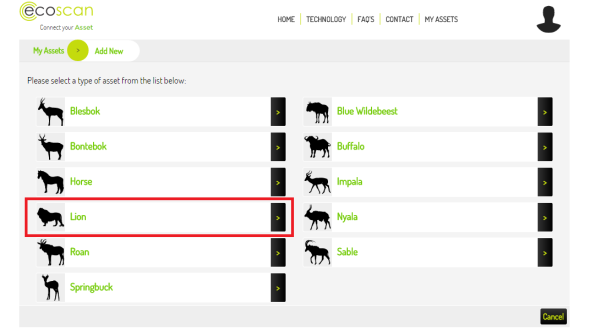 ECOSCAN is a system that Ukutula Lion and Research Center uses to sell animals on to buyers. Ukutula Lodge has also implemented into their terms and conditions one of the following rather interesting rules:
ECOSCAN is a system that Ukutula Lion and Research Center uses to sell animals on to buyers. Ukutula Lodge has also implemented into their terms and conditions one of the following rather interesting rules:
- Buyers must agree to the animal being chipped that both ECOscan and Ukutula Lodge monitor.
However what Ukutula Lion and Research Center do not tell you is that the buyer once they breed that Lion, them cubs are immune from this system. So after birth has taken place Ukutula Lodge has then distanced themselves from the questionable buyer. Meaning its “more than likely that hunting is occurring”. Lastly on checking with South African lawyers no buyer of any Lion from Ukutula does not under any circumstances have to agree with Ukutula’s terms of policies/agreements Etc. A very crafty move by an alleged Lion Research Center, one of which the public cannot easily trace that buyer too. Please view image below and click on the image to view which British Travel Agency supports it, alternatively please click >here<
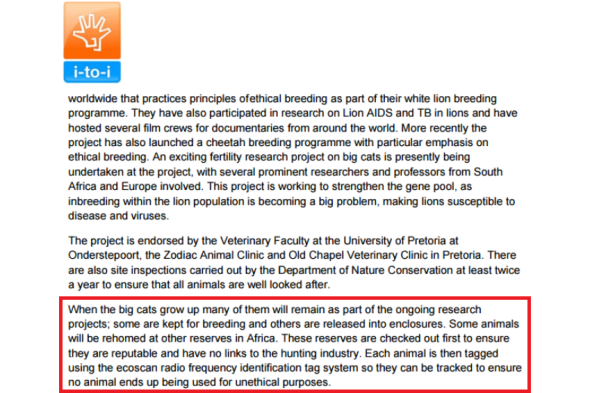
Image: Volunteer Travel I-I UK supports Ukutula Lodge that Blood Lions called into question.
Last month the South African Non Governmental Organisation, Blood Lions called into question Ukutula Lodge that refused to allow the Blood Lions team onto their property to investigate claims in relation to canned hunting. To read more on that subject please view the link below:
http://www.bloodlions.org/us-volunteer-speaks-out-cubs-hired-for-parties-and-events-ukutula/
The last thing we ever wanted to be forced to do was to begin exposing the petting industry at an angle that sees us exposing those that directly contribute to the industry that has skyrocketed over the past ten years. Unfortunately we’re being forced too. We’ve provided more than enough facts, accounts, and evidence. What or more to the point how much more evidence do students, tourists and volunteers really require?
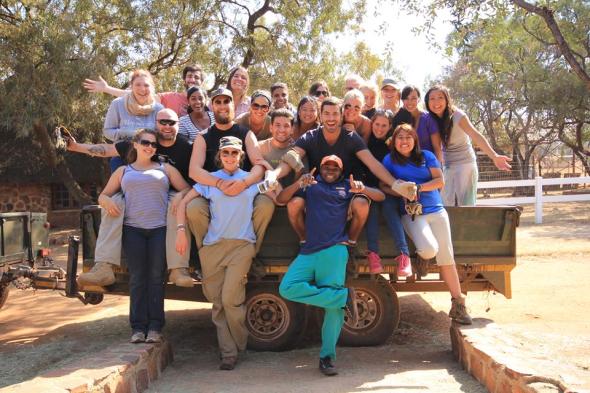
Image: Students at the Living with Big Cats Project.
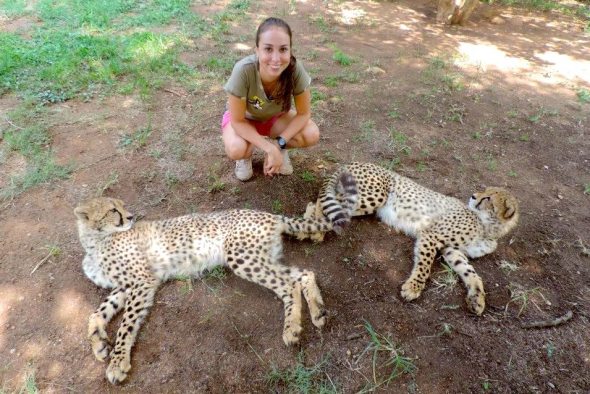
Image: Student at the Living with Lions Project.
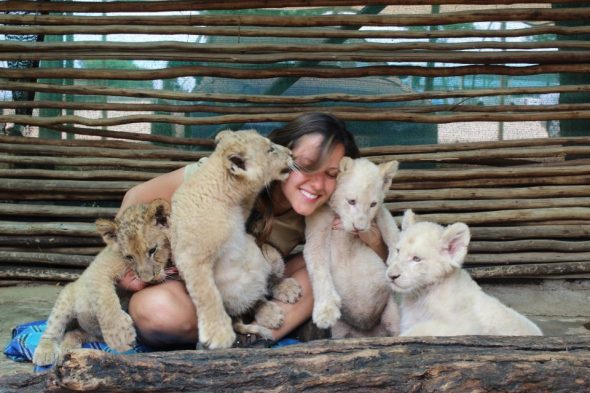
Image: Student at the Living with Lions Project.
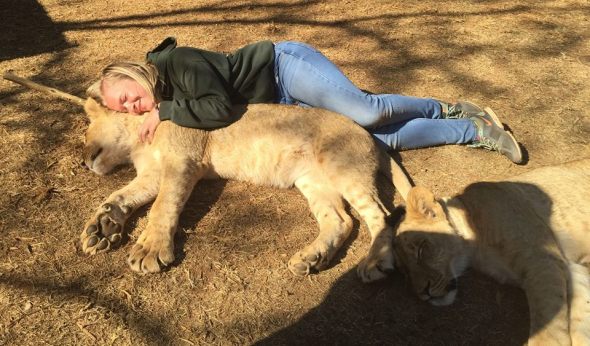
Image: Student advertised on the UK Travel Firm Amanzi Travel UK.
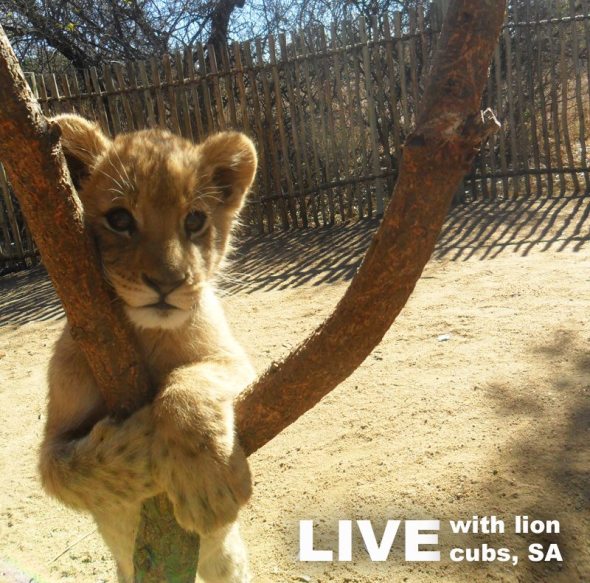
Image: Lonely cub advertised for petting at the I to I Volunteering UK agency.
No money the public spends to pet or take photos with cubs ever goes to support conservation in the wild. In fact, the opposite is true. There is a huge and growing market for Tiger and Lion parts, and Tiger and Lion “derivatives”, i.e. products made out of Tiger and Lion parts like Tiger and Lion bone wine. A dead Tiger/Lion is worth up to $50,000 for its parts. Breeding what US Fish and Wildlife Service calls “generic” Tigers like the ones used in the mall exhibits is not tracked, similar to ECOscan system used by various lodges and parks in South Africa. So there is no way to know how many born Tigers/Lions are killed to have their parts illegally sold into this trade. And, the more that trade expands, the more incentive the poachers, hunters and farmers have to kill Tigers and other big cats in the wild and via hunting within South Africa. Yes sadly, farmers and lodges, parks and alleged “living with big cats programs’ will sell after hunting (in some if not all cases) bones on to the Asiatic market to double their money. All supported by you the volunteer, tourist and student.
RECAP:
The cubs used for petting exhibits/farms Etc are torn from their mothers shortly after birth, causing emotional pain to both the cubs and the mothers. Imagine what that mother experiences after enduring the long pregnancy and finally giving birth, filled with the instincts to nurture her cubs, and then having them snatched away. The breeders take them away and have people handle them so the cubs will “imprint” on the people instead of doing what is natural and imprinting on their mothers.
And what is life like during the months they are used to make money for their owners? Cubs this age want to roam, explore, test their young muscles to develop coordination, and sleep for extended periods of time without interruption. Watch what happens during these exhibits. The cubs are repeatedly awakened so a customer can pet them instead of being allowed the sleep their young bodies need. When they try to wander they are repeatedly yanked back. And where are they when not on exhibit? Well I’m sure you can answer that question. A nursery maybe? Possibly, without the mother that is pining for her young? Just because its a cozy looking nursery means nothing.
Thank you for reading.
Dr Jose C. Depre.
Chief Environmental Officer and CEO;
PhD. MEnvSc. BSc(Hons) Botany, PhD(NeuroSci) D.V.M. Environmental & Human Science
Environmental and Animal Rescue Investigations Chief Officer.

